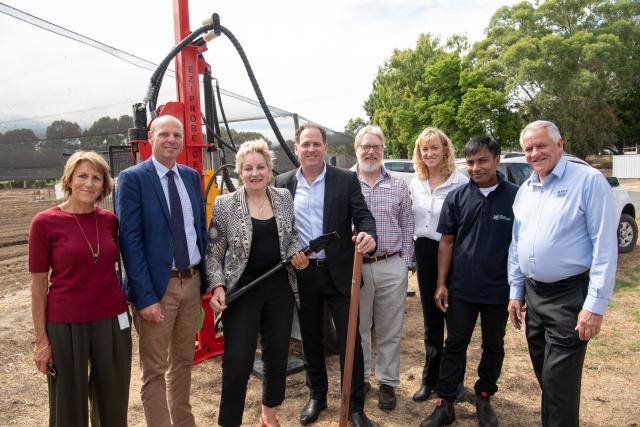New research projects to address WA grains production constraints

A suite of new grains research projects led by the Department of Primary Industries and Regional Development is about to get underway, as part of a substantial investment by the State Government and the Grains Research and Development Corporation (GRDC) to boost productivity and profitability.
The State Government has contributed $22 million towards three soils projects, together worth $42 million in total over five years.
A further $3 million has been invested by the State towards three pilot projects, worth $6 million over the next three years, to boost oat, canola, lupin and pulse production in Western Australia.
The work will build on the department’s extensive soil amelioration research over the past 10 years, as well as explore new approaches to matching genetics with early sowing opportunities for oats, canola and lupins.
The projects are designed to overcome key WA production constraints and to generate enduring profitability to Western Australian grain growers and transformational benefits across the industry.
Soils projects
Three projects will address the State’s main soil constraints to production, including non-wetting, compaction, sub-soil acidity, sodicity and salinity.
Geraldton research officer Dr Steve Davies is leading a $22.09 million ‘Re-engineering soils to improve the access of crop root systems to water and nutrients stored in the subsoil’ project, over five years.
This work will address multiple, interacting soil constraints in the crop root zone, by applying strategic combinations of soil amelioration techniques or by full soil profile re-engineering.
Soil profile re-engineering is the fundamental redesign of soil profiles to achieve dramatic improvements in critical measures of cropping performance, including water and nutrient use efficiency, grain yield and grower profitability.
Esperance senior research officer David Hall is heading up a four-year, $4.08 million project to ‘Increase grower profitability on soils with sodicity and transient salinity in the eastern grain belt of the Western region’.
Interacting combinations of sodicity and transient salinity are often associated with high subsoil pH, ion toxicities (mainly boron) and poor subsoil structure, which interact to prevent crop roots from accessing water.
This project will explore and develop management options for soils affected by these constraints to improve plant root water accessibility and resulting yields.
Dr Davies and his Geraldton colleague, research officer Christine Zaicou-Kunesch, are leading the five-year ‘Increasing farming system profitability and longevity of benefits following soil amelioration’ project, worth $15.48 million.
This project seeks to sustain the gains from new soil amelioration and amendment treatments by identifying management changes that will preserve the benefits of soil amelioration.
The work will determine the most profitable crop rotations, species choice and seedbed preparation to sustain long-term benefits from soil amelioration while managing risks, such as wind erosion and poor crop establishment.
Agronomy projects
Northam research officer Georgie Troup is the leader of a two-year project to ‘Investigate the phenology diversity in germplasm and levers to optimise profitability from April sown oats’, worth $1.55 million.
The project will evaluate the phenology of a wide range of germplasm at two contrasting sites, Northam and Katanning, to identify suitable breeding lines for early sowing in WA.
Researchers will also develop agronomic packages for medium to high rainfall areas, to ensure new varieties meet stricter milling oat quality specifications.
Research officer Mark Seymour, based at Esperance, will spearhead a $2.26 million, three and a half year project to ‘Raise awareness, optimise yield and expand the area sown to lentils, chickpeas and faba beans in WA’.
This project will draw from GRDC-backed pulse research from across Australia to develop production packages to provide growers with evidence-based information, knowledge and confidence to sow these crops.
This project seeks to support an increase in lentil production in WA to 40,000 hectares in the next five years, and faba bean production to 20,000ha and chickpeas to 70,000ha.
A $2.09 million project to ‘Expand the sowing window for canola and lupin in WA’ is being led by Geraldton research officer Martin Harries for the next two and a half years.
This research will provide WA growers with agronomic insights on ways to boost the yield and profitability of canola and lupin crops by capitalising on early sowing opportunities and will include identifying commercial canola and lupin varieties that are likely to be better adapted to very early sowing.
Transformational change
DPIRD is well placed to deliver these projects, many of which have evolved from years of department soil, nutrition and agronomy research.
These projects will also explore new cropping opportunities, complementing the department’s long-term break crop work.
The WA grains industry can be assured DPIRD has both the resources and the expertise to help it take production to the next level, backed by our highly qualified, passionate staff based throughout the grainbelt, dedicated facilities – including the Northam Grains Research Facility – and extensive field work with growers.
More information about these and other DPIRD grains projects can be found on the department's website.
